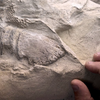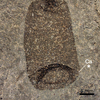A New Explanation for the T-Rex's Stubby Arms

Sue the Tyrannosaurus rex, sporting the dinosaur's tiny arms. (Source: Field Museum of Natural History)
Certain debates persist across paleontology, but perhaps none as thorny as the evolutionary function of the T-Rex’s arms. To this day, no definite consensus has arisen to explain the fearsome predator’s miniscule appendages, with a host of theories circulating through the scientific community.
The theories run quite the gamut, from the idea that the arms functioned as weapons to trap prey while feeding, or that they were used during group feedings over a carcass. Other more contentious ideas suggest they were used in mating or simply to help the T-Rex stand up from a resting position, but both of these present problems: there are no meaningful differences in the arms between males and females, and the arms would not be long enough to help the T-Rex fully stand.
A more recent theory makes no attempt to explain the arms’ function, rather it suggests that the arms served no purpose at all and were simply holdovers from an earlier stage of evolution. This suggests that had T-Rexes not perished along with the other dinosaurs, they may have eventually lost their arms altogether. Evolution is always at work, constantly refining species into new forms. The fossils we uncover only tell part of the story, who knows what other innovations evolution might’ve spawned from the dinosaurs had their story not been cut short.
Featured Product
Joe Frazier Boxing Glove
Cool Things!

Is “Paul is Dead” Dead?: Unpacking One Of Pop Culture’s Most Enduring Conspiracy Theories

Scientists Discover Hooves and Skin in Preserved Dinosaur "Mummies!"
A dinosaur discovery just in time for Halloween! In a new analysis of a group of fossils from Wyoming, Scientists have determined this group of fossils are dinosaur “mummies,” with preserved skin and even hooves.

Scientists Record a Bat Catching Birds Mid-Flight!
Bats, birds, screeches, oh my! In a reverse-Hitchcock twist, a new study reveals that a species of European bat catches and eats birds mid-flight.
Specimen Deep Dives

The House that Ruth Built: The Story of the Old Yankee Stadium

The Queen of the Skies: the Story of the Boeing 747

Old Ironsides: The USS Constitution and the Start of the U.S. Navy
Long Form Articles

The Artist Behind the Macintosh: Susan Kare and Apple Computers
While the two Steves, Jobs and Wozniak, are the most well known faces behind Apple computers, equally important to the products and culture of the company were those who crafted the experience of using their computers through design. The most notable of these visual architects was Susan Kare, a designer responsible for “humanizing” Macintosh computers.

Can I Lick It? Yes You Can!
Have you ever been unable to tell if a fossil was really a fossil, but you were too embarrassed to admit it? Have you ever wanted to lick a fossil just because, but you didn’t want to risk judgment from your peers? Well, good news! You can kill two birds with one stone! Licking a fossil can actually help you determine if it’s the real deal or just another rock.

Is It Legal To Own a Meteorite: How to Start Your Outer Space Collection!
Meteorites are some of the rarest geological specimens to be found on Earth. Of course, since these stones are not of our world, purchasing them can sometimes be a confusing process. Is it legal to own a meteorite? In short, yes! Read on for help starting your cosmic collection!

















